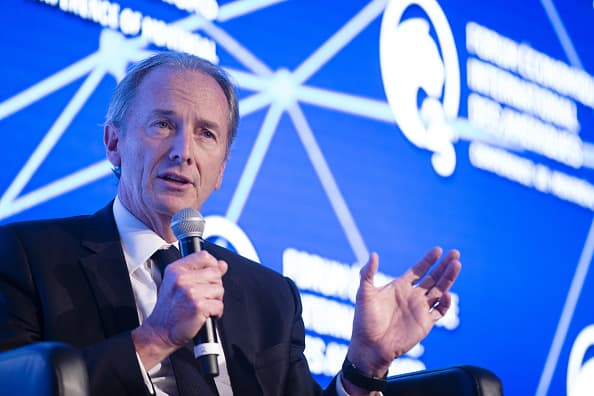
James Gorman, chief executive officer and chairman of Morgan Stanley, speaks during the International Economic Forum Of The Americas (IEFA) in Montreal, Quebec, Canada, on Wednesday June 12, 2019. Photographer: Christinne Muschi/Bloomberg via Getty Images
Bloomberg
Financial services firms are moving out of their comfort zone.
Some of the most recognizable names on Wall Street, such as Morgan Stanley and Goldman Sachs, are scrambling to cater to all types of investors — not just the richest Americans. It’s also about everyday investors of more moderate wealth.
Morgan Stanley announced Thursday that it is buying E-Trade, an online brokerage and digital bank, for $13 billion.
The purchase — the biggest takeover by a U.S. bank since the 2008 financial crisis — underpins the move among wealth management firms to plug a decades-long gap in financial advice that saw firms primarily seek out multimillion-dollar households as clients.
Morgan Stanley — a behemoth among wealth management firms, with nearly 15,500 financial advisors and $2.7 trillion in client assets — has an average account size that’s roughly two and a half times larger than E-Trade’s.
E-Trade clients, many of whom are hands-off, do-it-yourself-type investors, have a $69,000 average account size. Morgan Stanley clients have an average $175,000.
“This industry for three decades or more has always been moving upmarket,” said Dennis Gallant, a senior analyst at consulting firm Aite Group. “All firms are [now] moving to target smaller investors.”
This “land rush” for more mom-and-pop investors, Gallant said, is a positive trend for consumers, putting financial advice at the fingertips of a population that hadn’t previously had access.
However, it introduces uncertainty for E-Trade’s 5.2 million clients, who are likely wondering how the deal will impact their service, according to some analysts.
“If you are an existing E-Trade customer, there’s the potential down the road that things are going to change, whether it be account structure, pricing or offerings,” said Greg McBride, CFA, chief financial analyst for Bankrate.com. “That can change for better or worse.”
This push to work with households of all kinds is not unlike similar moves by firms outside the financial services arena. Amazon, for example, started out as an online book retailer and has since expanded to sell a wide array of consumer goods.
Digital technology has helped usher in a dramatic shift among financial services firms, which can leverage the technology to reach everyday investors more profitably and also get a better view of overall household finances — not just investments, but others areas such as debt. That helps firms serve as a sort of one-stop-shop for consumers’ financial needs, analysts said.
Robo-advisors like Betterment and Wealthfront that rose to prominence in the early part of the last decade use algorithms to manage money for investors more cheaply. Giants like Vanguard Group and Charles Schwab have since seized on the trend and meshed robo-advisors into their traditional financial-advice operations.
Morgan Stanley will merge its full-service, financial-advisor-driven business model with E-Trade’s digital brokerage and banking business.
This industry for three decades or more has always been moving upmarket.
Dennis Gallant
senior analyst at Aite Group
Online banking can help younger people consolidate loans, manage a budget and build short-term savings, and also help retirees who need a place to park money being withdrawn from investments, Gallant said.
Morgan Stanley chairman and CEO James Gorman said he intends to leverage E-Trade’s digital presence to appeal to more workplace customers, as well, a largely untapped market that may be looking for access to cheaper financial advice and other services.
Goldman Sachs is another firm that’s made notable strides to build out its services across various age and wealth bands.
Last year, the investment bank bought United Capital, a financial advice firm managing $25 billion, in a bid to expand into the ranks of less-affluent clients. It launched an online retail bank called Marcus, and partnered with Apple on a new credit card the tech giant rolled out last year.
Morgan Stanley, Goldman and other firms expanding their customer base likely aim to keep younger customers long-term as they grow wealth and turn to the firm for more help, and to sell a broader array of services to current customers.
“They’re running plays from the same playbook,” McBride said of Morgan Stanley and Goldman Sachs.
“They don’t want to be limited to just one lane on the highway,” he said. “They want to reach across various customer segments.”
The E-Trade acquisition comes on the heels of a shake-up among discount brokerage firms, many of which have dropped their trading commissions to zero.
Charles Schwab announced in November it’s buying discount brokerage rival TD Ameritrade for $26 billion, creating a firm with more than $5 trillion in client assets.
Morgan Stanley will have more than $3 trillion in client assets after the deal closes, expected in the fourth quarter this year.



